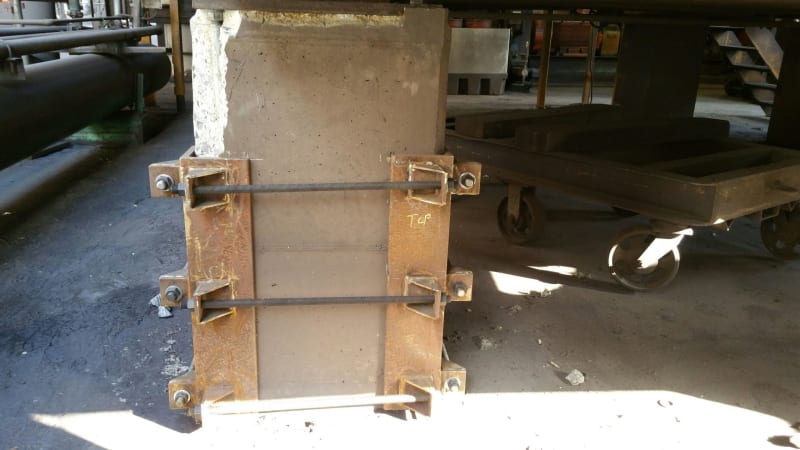patelam
Civil/Environmental
- Jan 27, 2022
- 37
The concrete column, 32"x 32", approx 8ft tall is supporting mechanical equipment (condenser). The are four columns such as this, supporting equipment. Each of these columns are cracked at top 1ft, some of them has 4" deep (horizontally)concrete chunks spalled off without exposing any rebars. The rebars are supposed to be 3" deep as per drawings. On scanning the column faces, it is found out that top 1ft of all columns has no rebars. The forces acting on columns are vertically downwards, no horizontal forces as the base of equipment has bolt holes larger than bolt dia to allow for movements.
I am looking for various options to reinforce the top 1ft portion of unreinforced concerete of column:-
1. Wrapping FRP laminates. ACI 440.2R can be used to design the externally bonded FRP layers
2. Adding a concrete jacket around unreinforced concrete of column with vertical rebars and ties in it. I don't think so that the concrete inside the jacket will behave the same way as the reinforced concrete behaves. I think the concrete in the core will not have its strength increased from the jacket around it. The jacket will be effective only after the concrete core breaks further and exerts any force (latera) on the reinforcement in jacket. Is there a paper or standards that I can refer to design the concrete jacket?
3. Adding a steel jacket around unreinforced concrete, forming a steel tube with concrete inside. I have same questions as I have in the option of concrete jacket. Would steel jacket be effective before the original unreinforced concrete fails? Also, do we have paper or standards to design steel jacket?
Can you suggest any other option to reinforce the column?
I am looking for various options to reinforce the top 1ft portion of unreinforced concerete of column:-
1. Wrapping FRP laminates. ACI 440.2R can be used to design the externally bonded FRP layers
2. Adding a concrete jacket around unreinforced concrete of column with vertical rebars and ties in it. I don't think so that the concrete inside the jacket will behave the same way as the reinforced concrete behaves. I think the concrete in the core will not have its strength increased from the jacket around it. The jacket will be effective only after the concrete core breaks further and exerts any force (latera) on the reinforcement in jacket. Is there a paper or standards that I can refer to design the concrete jacket?
3. Adding a steel jacket around unreinforced concrete, forming a steel tube with concrete inside. I have same questions as I have in the option of concrete jacket. Would steel jacket be effective before the original unreinforced concrete fails? Also, do we have paper or standards to design steel jacket?
Can you suggest any other option to reinforce the column?

